Constant Volume Regulators: Understanding Their Role and Benefits
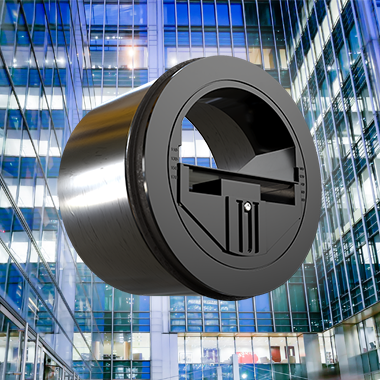
Maintaining a consistent indoor temperature in buildings that is 30-50°F warmer or cooler than the outside temperature can be quite the challenge. HVAC systems are designed to keep occupants comfortable and healthy while managing costs effectively. One common issue in multi-floor supply and exhaust systems is balancing air distribution. Variations in fan pressures and thermal stack effects can cause uneven supply and exhaust air distribution across floors, affecting humidity, air quality, and energy costs. Constant Volume Regulators (CVRs) offer a straightforward, cost-effective solution to these problems by automatically controlling airflow without the need for electrical controls or sensors.
Addressing Key Challenges
Fan-Induced Pressure Variations
In multi-floor buildings, HVAC systems often serve multiple floors, with fans connected to ducts running through the building. Each floor has a branch duct connected to the main duct. Without proper balancing, floors closer to the fans receive more air than those farther away. Traditionally, balancing dampers are installed at each branch and outlet/inlet to equalize air distribution.
For instance, in exhaust systems, floors near the fan typically deliver more air, following the path of least resistance, leaving lower floors with less air. Installing a CVR at each inlet/outlet can address this issue. The CVR dynamically adjusts to maintain its airflow set point, ensuring even distribution across all floors.
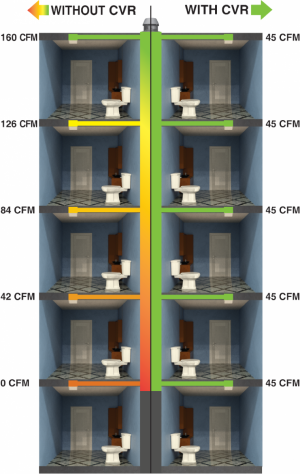
Mitigating Stack Effect Challenges
The thermal stack effect occurs due to the difference in pressure between the inside and outside of a building, causing air to enter or exit at different points. In colder climates, warm air rises, creating high pressure at the top of the building and low pressure at the bottom, leading to cold air being sucked in at the bottom and hot air expelled at the top. In warmer climates, the reverse happens: cold air sinks, creating high pressure at the bottom and low pressure at the top, causing hot air to be sucked in at the top and cold air expelled at the bottom. This uneven ventilation results in energy waste and humidity issues.
CVRs help maintain consistent air supply/exhaust despite these dynamic pressure changes. Unlike traditional static dampers, which are set based on initial conditions, CVRs automatically adjust to pressure fluctuations, ensuring balanced airflow and mitigating the effects of thermal stack.

What is a CVR?
A Constant Volume Regulator (CVR) is an ingenious device used in HVAC systems to control air velocity without the need for external controls or sensors. It consists of four main components: a cylindrical main body, a seal, a lockable and adjustable plate, and a self-adjusting flap. The main body houses the regulating blade and airflow settings. The seal ensures an airtight connection with the ductwork. The adjustable plate sets the desired airflow rate, and the self-adjusting flap, controlled by a spring, maintains consistent airflow by adjusting to changes in air velocity.
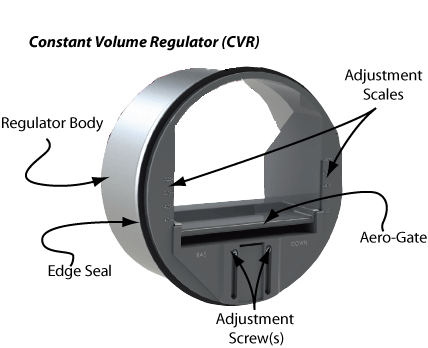
Benefits of Using CVRs
CVRs are suitable for various applications requiring consistent airflow in variable air systems. They work for both intake and exhaust applications without additional modifications. Their simple installation, lack of controllers or sensors, and minimal maintenance make them a cost-effective solution. CVRs can be installed post-construction to address air distribution issues effectively.
CVR Options
CVR Models:
- CVR-LP: Low Pressure (0.08″ – 0.4″ w.g.)
- CVR-SP: Standard Pressure (0.2″ – 0.8″ w.g.)
- CVR-HP: High Pressure (0.6″ – 2.4″ w.g.)
These models can include shims for lower airflow in larger ducts and are easily installed by sliding them into the designated duct size. The seal ensures an airtight fit.
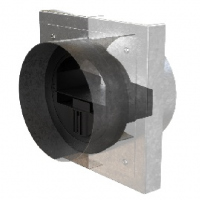
CVR-T: Features a factory-mounted duct transition for installation in square or rectangular ducts.
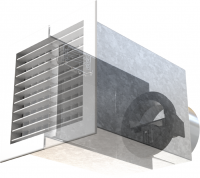
CVR-FD: Combines a CVR with a UL 555 Listed 1-hour static or dynamic curtain fire damper in a flanged box with a grille, reducing installation time and eliminating the need for rear retaining angles.
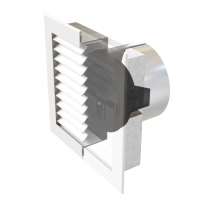
CVR-GM: A factory-assembled CVR in a flanged plenum box with a grille, ideal for applications where fire dampers are not required. It comes preassembled for quick installation.
Constant Volume Regulators provide an elegant and efficient solution for balancing multi-floor supply and exhaust systems, ensuring consistent airflow and improving overall HVAC system performance. To learn more: